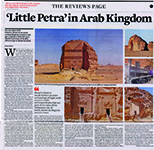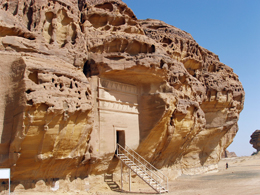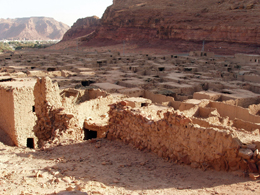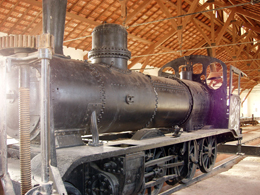Meda'in Saleh: A Visit Not To Be Missed By Those Going To Sa’udi Arabia |
 |
<<Click to see original |
With the recent completion of the annual Hajj pilgrimage, it would be interesting to know how many – if any - Hajjis rounded off their trip to Sa’udi Arabia with a visit to what must be one of the Kingdom’s most beautiful and fascinating sites – a place that has remained a well kept secret from the globe-trotting culture-seeking tourists who are constantly on the look out for “unspoiled” destinations across the globe.
For those who are able to gain entry to this fascinating country, the immediate attractions of Riyadh and Jeddah, not to mention the religious tourism destinations, are often the only places that travellers will visit. Yet for sheer breath-taking splendour, variety, historical interest and something that is so very ”different”, it is hard to beat Sa’udi Arabia's "Little Petra", known as Meda'in Saleh.

This is truly the Kingdom's premier archaeological site, with ancient tombs that are part of the ruins of the Nabataean city of Saleh, known as Hegra in ancient times.
Mada'in Saleh itself covers nine square kilometres and includes about 130 fabulous tombs built on a 450-metre plateau. These monumental mausoleums were carved into the sandstone about 2,000 years ago by Nabataeans who originated in Iraq and migrated to Petra in present-day Jordan and to Meda'in Saleh, some 320kms to the south.

The first tomb near the entrance is that of Al Sanai, a breathtaking sight with its towering facade featuring elegant etchings of eagles and roses. Al-Khasraf is a cluster of 17 tombs with mysterious, elevated entrances. The lone, frequently photographed Al Farid tomb is the largest and was never finished. The Girls' Palace consists of 23 bi-level tombs with carvings that depict family life in the community.
Many of the tombs feature etched inscriptions which depict names of the family dynasty and those chosen to be buried there. Many are dated. Several bear the carver's signature. Inscriptions like this are common at other Nabataean burial sites, but very few were found in Petra. (Some have suggested that the inscriptions in Petra were painted onto white plaster, which would have crumbled over time.)
As in Petra, you can wander into most of the chambers and see inscriptions and chisel marks on the roughly-hewn walls. Small ledges, supposedly graves for children, were cut into walls of some of the rooms. Other graves were dug into the floors.
And just as in Petra, there is a "siq", or narrow gorge that separates two huge sandstone outcrops. It leads to an open hall cut into the rock. Several small niches with inscriptions are carved into the walls and many believe they once held figures of deities.

Many travellers to Meda'in Saleh plan side-trips to the archaeological sites at Al-Ula, which includes a ghost town – empty now for over 50 years - together with its many rock carvings, as well as to the Hejaz Railway.
The main purpose of this railway was to establish a connection between Istanbul, the capital of the Ottoman Empire and the seat of the Islamic Caliphate, and Hejaz in Arabia, the site of the holiest shrines of Islam and the holy city of Makkah; but it only ever reached Medinah 400 km short of Makkah, due to the interruption of the construction works caused by the outbreak of World War I.

Another important reason for the railway’s existence was to improve the economic and political integration of the distant Arabian provinces into the Ottoman state, and to facilitate the transportation of military troops in case of need. It was thus made famous by Lawrence of Arabia who famously destroyed the southern end of the railway in 1917 in an attempt to thwart the Turks who controlled it
One of the reconstructed Hejaz Railway stations lies next to the Meda'in Saleh archaeological site. This was one of the largest railway stops, and has the station, warehouses, bunk houses for troops and an engine servicing facility. There is a rusty old German steam locomotive (a JUNG No. 60) in its shed, with several carriages outside in the yard, whilst the platform areas have been reconstructed with extra modern lighting and restored to their as-built appearance.
Further up the line you can see derailed locomotives, coal tenders and wagons, riddled with bullet holes, but most are accessible only with a four-wheel-drive vehicle. Many of the railroad embankments, culverts and bridges remain intact, along with a few Turkish forts dating back well over a century.
Getting to Meda'in Saleh involves a plane flight to either Medinah airport (situated outside the Haram zone, so non-muslims are able to land here) or to Al Wadj on the Red Sea coast. It is located about 850km from Jeddah, halfway between Tabuk and Medinah. The hotels at Meda'in Saleh will pick visitors up from these two airports, even though they are 400kms and 200kms away respectively. The Medinah trip is much more interesting, and normally a stop is made on the way to admire the pre-Islamic Khaibar dam.
You need permission to visit Meda'in Saleh, though, from the Ministry of Antiquities in Riyadh, but if you stay at a local hotel or use a tour operator, they will normally sort this out for you as long as you give them a few days notice.
Recommended months to visit Meda'in Saleh are from November to March, as it can otherwise get extremely hot – typically well into the 50s in the summer. The Department of Antiquities publishes a self-guide tour booklet that is available at the site for SR25 (US$7). In common with other archaeological sites in Sa’udi Arabia, video at Meda'in Saleh is not allowed, though stills photography is not a problem.
